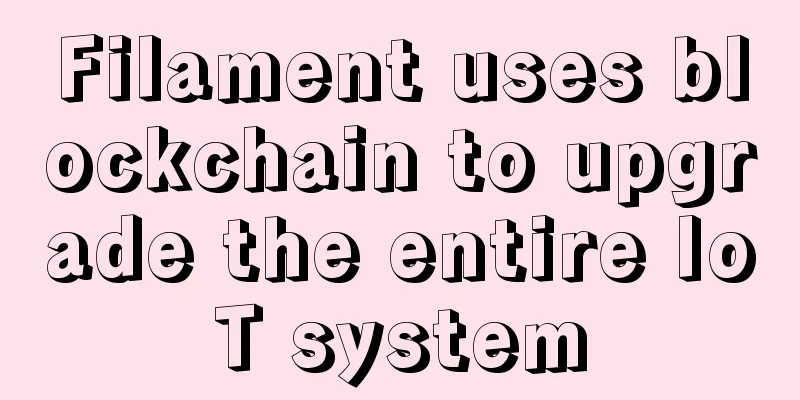Filament uses blockchain to upgrade the entire IoT system

|
Rage Review : Filament, a US blockchain startup, is committed to using blockchain technology to transform and improve the Internet of Things system, achieve control of each key link, and reduce unnecessary resource loss and costs. The company has its own development direction and achievements, and also pays close attention to the dynamics and achievements of technology giants and industry pioneers. It is always prepared for the possibility of future technical cooperation. Translation: Annie_Xu Eric Jennings, CEO of IoT company Filament, revealed that the company’s blockchain deployment method is not new and “may not attract the attention of people familiar with blockchain.” Filament uses the bitcoin blockchain as an immutable ledger to record hashes of device payment receipts in a decentralized manner. Jennings has not hyped the blockchain application that constitutes the company’s main function.
Eric Jennings Jennings said the Filament system uses a system similar to the Lightning Network to conduct a small number of microtransactions. Filament has developed a "Penny Bank" protocol that has slightly different design goals from Filament, such as not requiring continuous online access.
Jennings pointed out that the currency exchange unit in the entire industry Internet of Things cannot be Bitcoin, at least not yet. "Our potential and existing customers are not paying attention to Bitcoin. They know about Bitcoin and understand blockchain, but they don't want to use Bitcoin for transactions. They also know its applicability and are paying attention to it."
Filament found similar thinking in Blockstack, a company that provides a decentralized domain name system. Jennings said:
To enable devices to transact and exchange value autonomously, Jennings said, phones could use Bluetooth to share blockchain-verified information. “If someone adds a new contract for each device, the device can get the Merkle receiving path from the smartphone.”
Filament started out by producing microcontroller control hardware, but later Ad hoc networks that did not require existing infrastructure began to dominate the industry. Filament soon began to provide equipment to Fortune 50 companies, and the nature of the company began to change. Jennings' friend Jeremie Miller, who had worked on the development of the TeleHash protocol, went from being a consultant to the company's CTO. The Filament team has long admired IBM and Samsung’s ADEPT projects, which use TeleHash. Last June, Filament began leading the IBM ADEPT research team and Samsung’s senior research team in Seoul. Jennings believes that it is a pity that IBM disbanded the internal ADEPT team, but IBM tends to position itself as a service-oriented company and a cloud service company. "So when the document says that we no longer need cloud services, people will certainly be frustrated. But even if they promote it positively, it is related to the deployment of the Internet of Things."
|
<<: Blockchain technology is a perfect solution for government services (development blueprint)
>>: Why has blockchain implementation in banking failed?
Recommend
People who don't like to express their opinions during discussions
In fact, many times, it is recommended that when ...
The nose of a woman destined to be rich in the future is upturned
For a person, his or her facial features often ha...
Moles on women's faces to predict marriage What does a mole on the corner of the mouth mean?
Moles on a woman's face to see her marriage, ...
Is it true that people with moles on their thighs are more likely to offend others?
How to interpret the mole on the thigh? In mole p...
Is it true that people with flat heads and broad foreheads are destined to become officials?
People who hold high positions are not necessaril...
The Biden era has begun. Looking at the regulatory trends of cryptocurrencies from the nominees of various regulatory agencies
Text | Nancy Edited | Tong Produced | PANews Afte...
What is Bitcoin Mining? For Venezuelans, it's the difference between life and death
Many people from troubled South American countrie...
Where on the body do men get betrayed by their friendships? How to judge whether a mole is auspicious or inauspicious?
Everyone has moles on their body to a greater or ...
The opportunities of Filecoin mainly lie in mining, but please be prepared to pay the "tuition fee"
Filecoin mainnet is about to be launched, and man...
BUIP041 (BUIP038 counter): Preventing a small number of hashing forces from launching large block attacks
0 182 question BUIP038 describes a small computin...
What are the current Bitcoin OTC trading methods and platforms? The Internet Finance Security Committee gives the answer
Phoenix.com WEMONEY News: On October 27, the Nati...
What does it mean for a man to have a square face?
Analysis of the square face People with square fa...
What does it mean if a woman looks good or not?
Women are Yin and men are Yang. There is a differ...
Is it good for people with moles on the nose?
Is it good for people to have moles on the nose? ...
Is a triangular face good or bad? A detailed explanation of the triangular face shape
Physiognomy is a folk knowledge that predicts fat...









